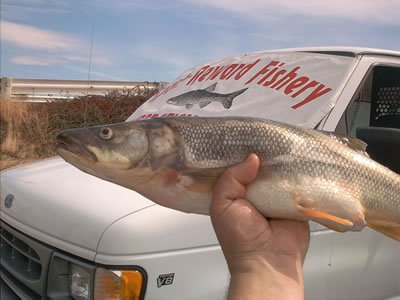How to Get Paid for Fishing and Help Salmon At The Same Time
- January 17, 2019
- John Harrison

Fishing for Northern Pikeminnow in the Columbia and Snake rivers paid well for one angler in 2018, who caught more than 8,600 of the predators and made more than $71,000.
That’s not the most ever paid to a single angler for removing the aggressive predator fish from the river ($119,000 in 2016), but it’s a lot. In answer to perhaps the most obvious question – where did he fish? – Steve Williams of the Pacific States Marine Fisheries Commission told the Council this month: “There is a great deal of competition among anglers, and for obvious reasons most are not interested in talking about where they fish or how they fish.”
Pacific States helps manage the sport reward fishery for Northern Pikeminnow in the Columbia and lower Snake rivers, a project funded by the Bonneville Power Administration through the Council’s Columbia River Basin Fish and Wildlife Program. The project pays anglers for catching – and not releasing – Northern Pikeminnow, which are predators of juvenile salmon and steelhead in the Columbia and Snake rivers. This month, Williams and representatives of Bonneville briefed the Council on the project’s 2018 results.
Studies in the reservoir behind John Day Dam prior to 1990 estimated that Northern Pikeminnow accounted for up to 80 percent of the predation on juvenile salmon and steelhead migrating to the ocean, and that the predation could be cut in half by removing 10-20 percent of the predator-sized Northern Pikeminnow (fish longer than nine inches) from the rivers. The reward fishery began in 1991.
The annual reward fishery season runs from May to September. The harvest area is from the mouth of the Columbia to Priest Rapids Dam, and in the lower Snake River from its confluence with the Columbia to Hells Canyon Dam. Pacific States oversees the technical, contractual and fiscal portions of the program, and the Oregon and Washington departments of fish and wildlife keep track of the number of fish caught, assess the biological effects of the fishery, and operate the check stations where fishers take their catch. There are 19 check stations along the Columbia and lower Snake rivers where state fish and wildlife agents register anglers and accept the fish they catch.
While sport anglers can fish anywhere along the Columbia and Snake rivers within the fishery boundaries, Williams said some of the most productive areas to catch pikeminnow have been at Boyer Park downriver from Lower Granite Dam, the mouth of the Yakima River, and near the Columbia River boat ramps at The Dalles, Oregon. The lower Columbia River between Bonneville Dam and the ocean also has had a consistently high catch rate.
It’s not just sport anglers who go after Northern Pikeminnow. A crew of four Washington Department of Fish and Wildlife employees fish from the tops of The Dalles and John Day dams. They drop their lines into the boat-restricted zones in front of and behind the dams, important areas for Northern Pike removal because that is where juvenile salmon and steelhead enter and exit, respectively, the fish bypass systems at the dams. The well-fed pikeminnows in those areas tend to be larger – up to 14 inches.
The reward fishery pays sport anglers $5 per fish for the first 25, $6 for the 25th to 200th fish, and $8 per fish after that. In 2018, more than 3,000 people registered for the fishery, 180,271 fish were caught -- a little fewer than the catch in 2016 and 2017 -- and Bonneville paid out about $1.4 million. The total cost of the fishery last year was $1.75 million.
The average number of fish caught per angler in 2018 was 7.52. According to a Bonneville news release, the top 20 anglers in 2018 earned an average of nearly $29,000 each. The top angler earned more than $71,000, bagging more than 8,600 fish over the five-month season.
Over time, anglers have caught more than 5 million Northern Pikeminnow through the reward fishery. Biologists estimate that the program has reduced predation on juvenile salmon and steelhead by up to 40 percent from pre-fishery levels.
“We have been able to affect the size and numbers of the larger fish, even though productivity of the species has not changed dramatically,” Williams said, adding, “but if we discontinued the program we’d see a lot more predation.”



